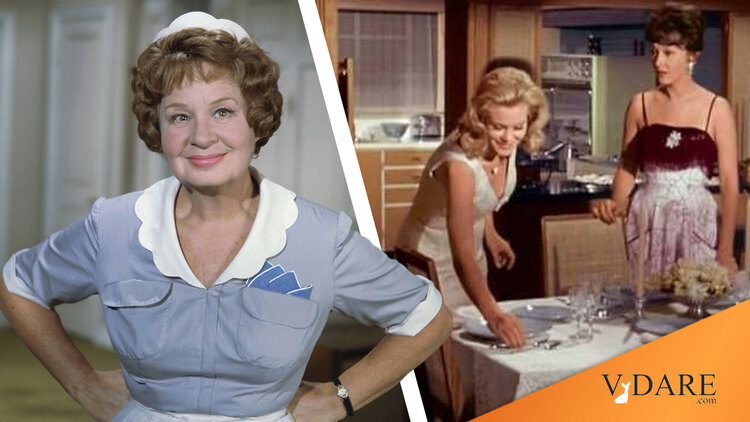
Housewives And Servants In Midcentury Immigration Pause America: "The Social Effects Of This Restrictive Policy Were Tremendous"
12/20/2022
Steve Sailer, below, writes in Claudia Goldin’s Model of Women and Work that
A century ago, middle class women typically had a servant or two to help out around the house. Then immigration was cut back in the 1920s and when servant girls went off to work in factories during WWII, lots of bourgeois matrons had to learn in mid-life how to do numerous household chores. (In Heinlein’s The Door Into Summer, the inventor of the first home robot chooses as the brand name of his mechanical maid “Hired Girl — it brought back thoughts of the semi-slave immigrant girl whom Grandma used to bully.”)
But this was taken on mostly in a spirit of supporting a more egalitarian America. In Professor-Admiral Samuel Eliot Morison’s Oxford History of the American People, from around 1970, he inserts a page of praise for matrons like his Boston brahmin wife, who had to learn how to keep house in midlife due to the democratization of American life.
Morison writes (this is from the 1972 paperback edition of Volume III, p. 235) originally written in 1964, about the social changes wrought by the Great Pause in immigration caused by the Immigration Act of 1924:
The social effects of this restrictive policy were tremendous. The foreign-language press declined in numbers and influence. The so-called “ghettos” in the cities where recent immigrants congregated in search of friends and jobs, gradually faded out; but new ones have been created by the migration of Southern Negroes and Puerto Ricans to Northern cities. Absence of cheap immigrant labor permitted average “real” weekly wages in the United States, which we left at $10.73 per week in 1914, to rise to $13.14 in 1926, despite an immense increase in the cost of living; and in the same period, real wages in the largely unionized building trades rose from $18.22 to $23.94, miners’ wages from $11.56 to $15.03, printers’ from $19.67 to $21.63, and others in like proportion. Labor “never had it so good” as in the years between the postwar recession of 1920-21 and the crash of 1929. So good, in fact, that the unions lost a large proportion of their dues-paying members.
Middle- and upper-class Americans outside the South had always been dependent on recent immigrants for domestic service; now that source was largely cut off. The number of “private household workers” — cooks, butlers, laundresses, housekeepers, and miscellaneous maids-declined between 1900 and 1950, although the total population in that period had increased 140 per cent. There are probably fewer than half a million domestic workers in the United States in 1964, although wages have risen spectacularly — from about $10 for a long week around 1900 [$300.72 in today’s money] to $65-$85 for a 5½ day week; [$624.23 to $816.30] all this without benefit of a union but with free board and lodging. The main reasons for this decline have been the reduction of immigration, and the increasing demand for women in war and other industries. This shortage of domestic “help” has been a social revolution in itself. It has increased the number of restaurants, since men and women who dislike working in a household seem to prefer the far greater drudgery in a public eatery. The rarity of domestic servants has stimulated the production of home labor-saving devices and of packaged, precooked, and frozen foods to save the housewife time and trouble. Private hospitality has progressively declined; it is now evident that the “gracious living’’ of past generations was made possible only by a household of skilled domestic servants. Cocktail parties have become the only practicable form of home entertainment, for all but the very rich. The people upon whom the weight of this domestic revolution has fallen are the women brought up with plenty of servants who now, in middle age, must perform every household chore for which they were not trained, and which they never expected to do. The brave and successful response to this challenge by America’s “thoroughbreds” is a tribute to their character, and one to which no male social scientist has yet alluded.
Steve referenced Heinlein’s 1957 novel The Door Into Summer, which predicted the invention of the robot vacuum cleaner:
That’s why we called the monster Hired Girl — it brought back thoughts of the semi-slave immigrant girl whom Grandma used to bully. Basically it was just a better vacuum cleaner and we planned to market it at a price competitive with ordinary suck brooms.
The point is that in 1957, Heinlein had foreseen the possibility of an automatic vacuum cleaner, not actually marketed until 2002, but he had not foreseen the Immigration Act of 1965 — he was living during the great pause.
Here’s how that would play out in popular culture: this is Shirley Booth as Hazel, a white American live-in maid to a suburban family with one child, in 1961-1965 show called Hazel.

How could the family afford her? Well, according to IMDB, “George Baxter was a highly successful corporation lawyer” and partner in a law firm.
This is Samantha Stephens (the blonde), a stay-at-home wife and mother who has magic powers (Bewitched, 1964-1971) but does not have a maid. She keeps house using normal human methods, and when she has a dinner party, below, it’s a small one that she cooks for herself. Her husband is a junior executive in Madison Avenue advertising firm.

What it shows is that during an immigration moratorium, Americans can do without foreign servants, and prosper besides.
